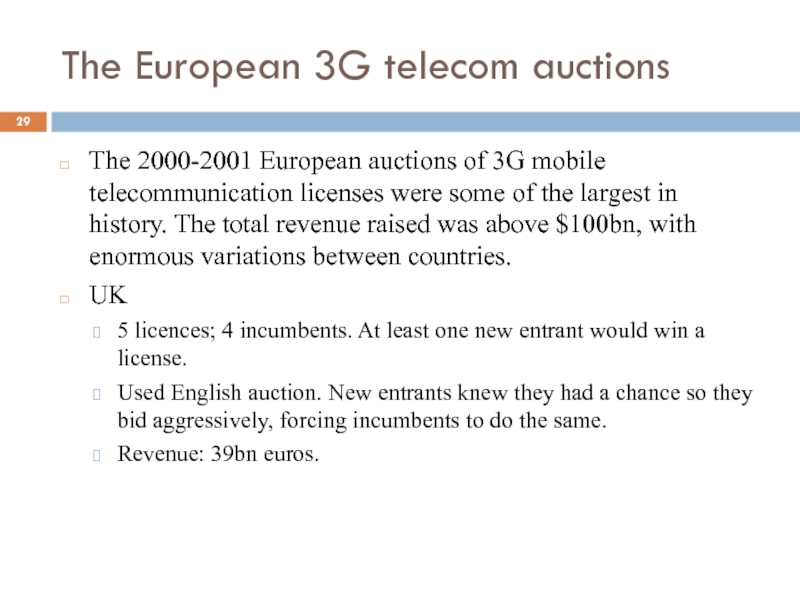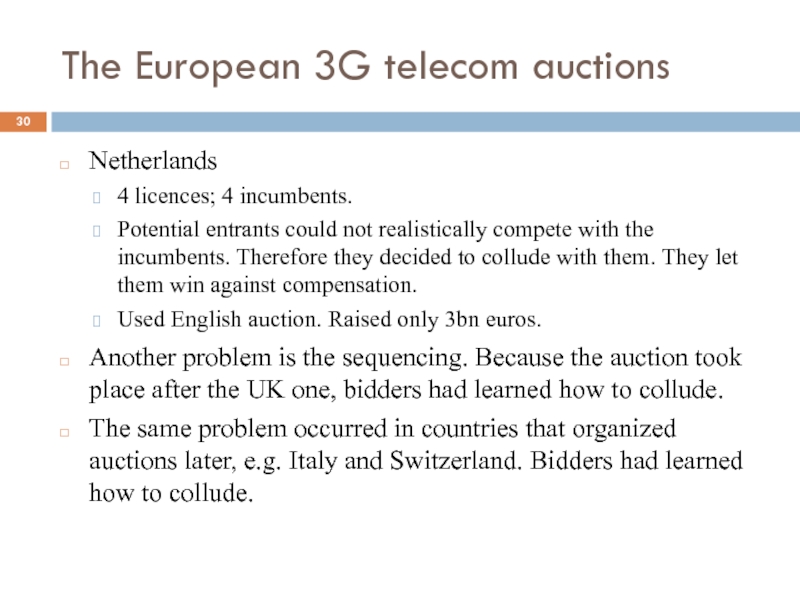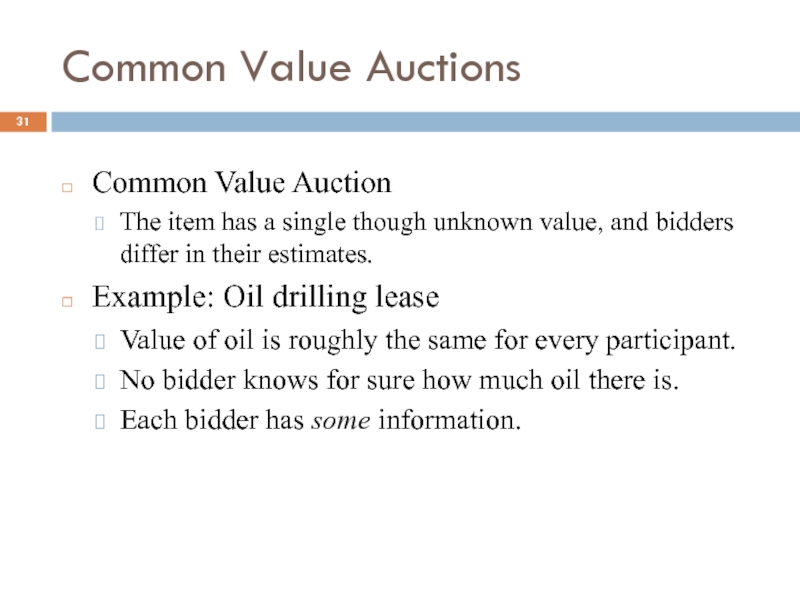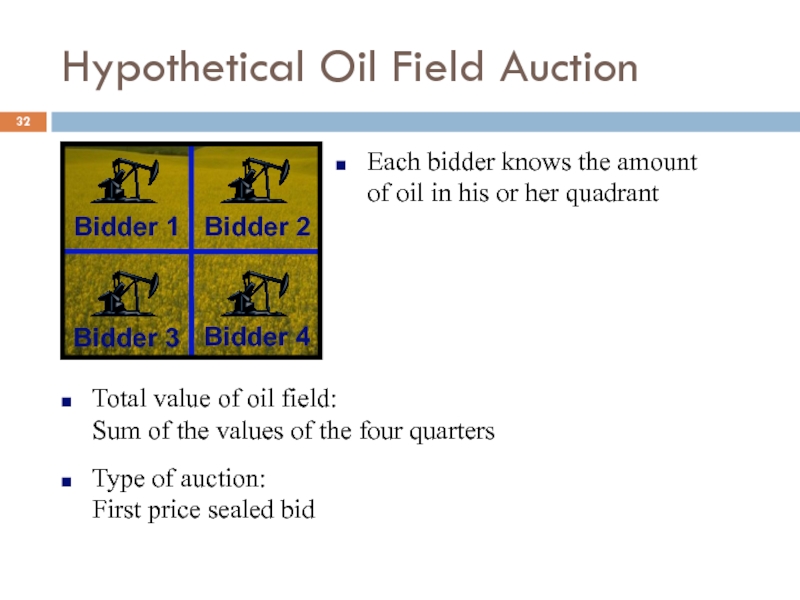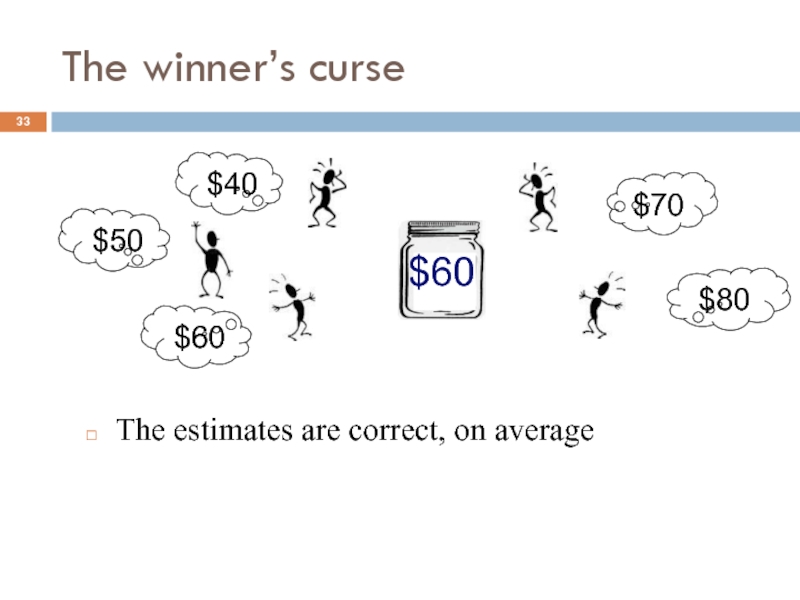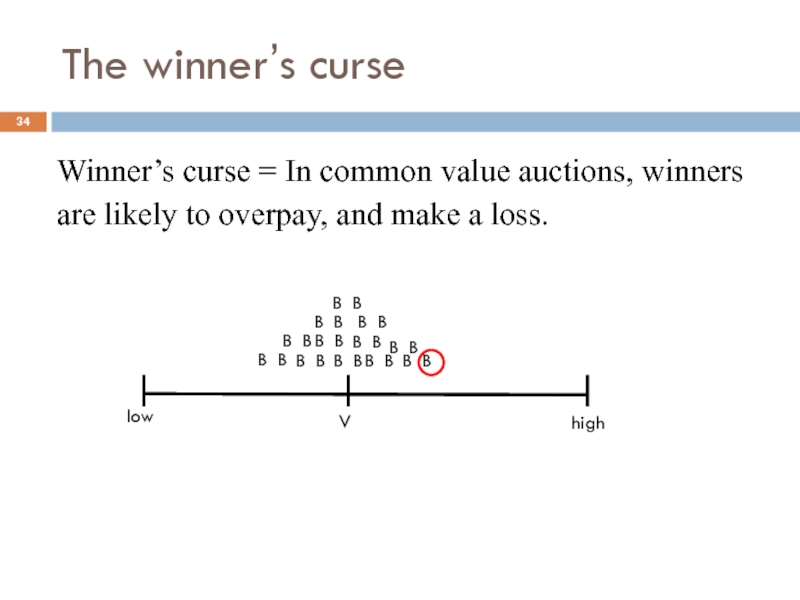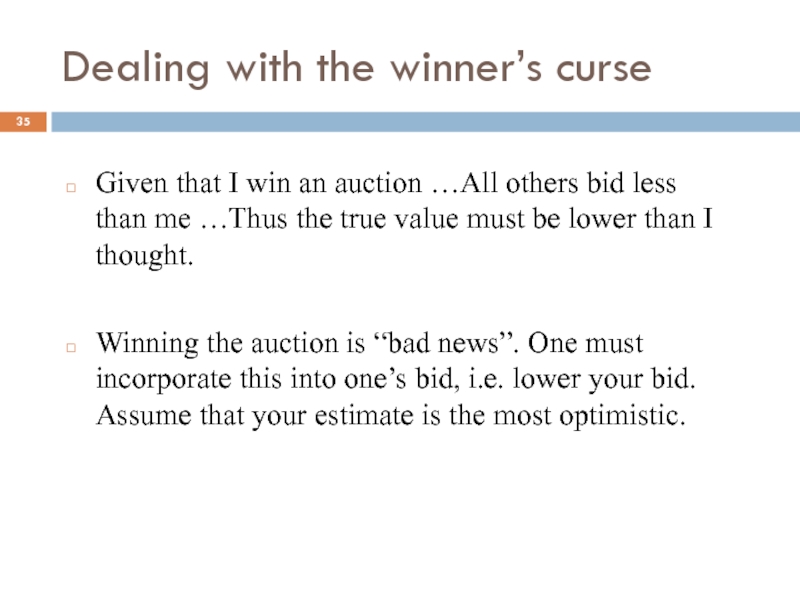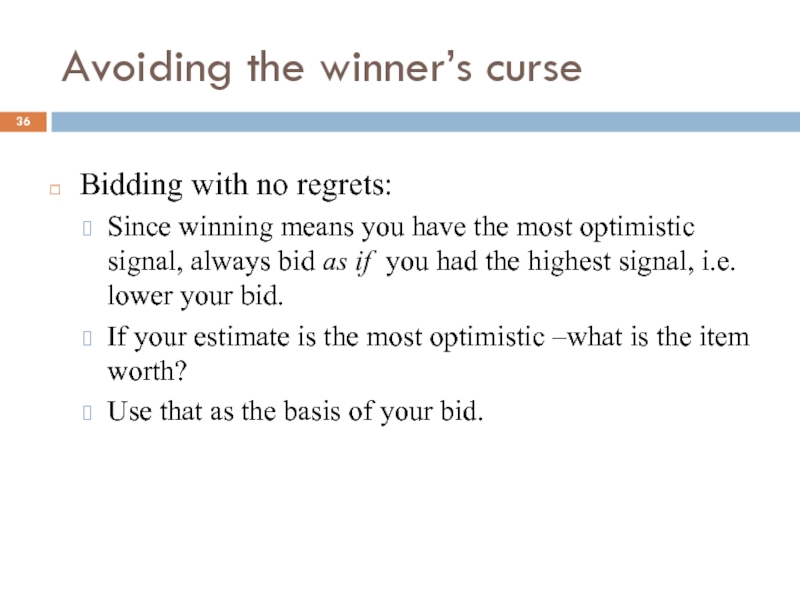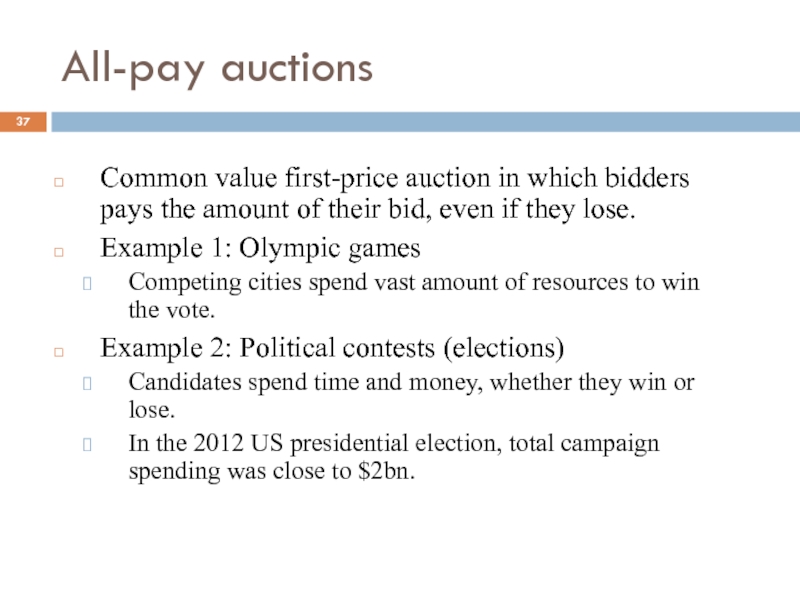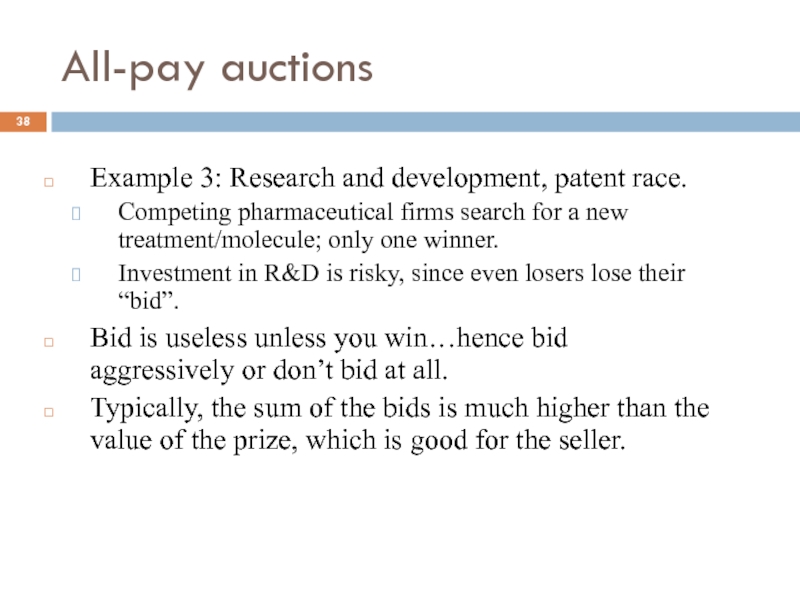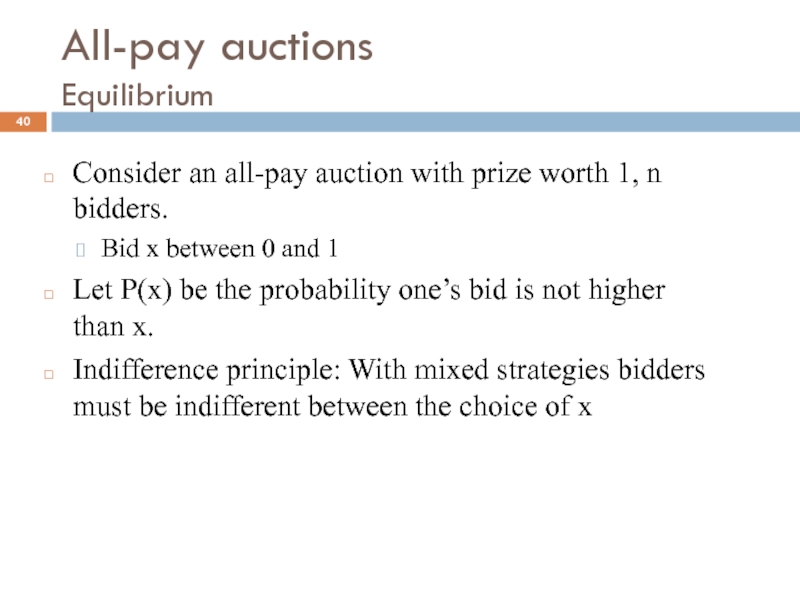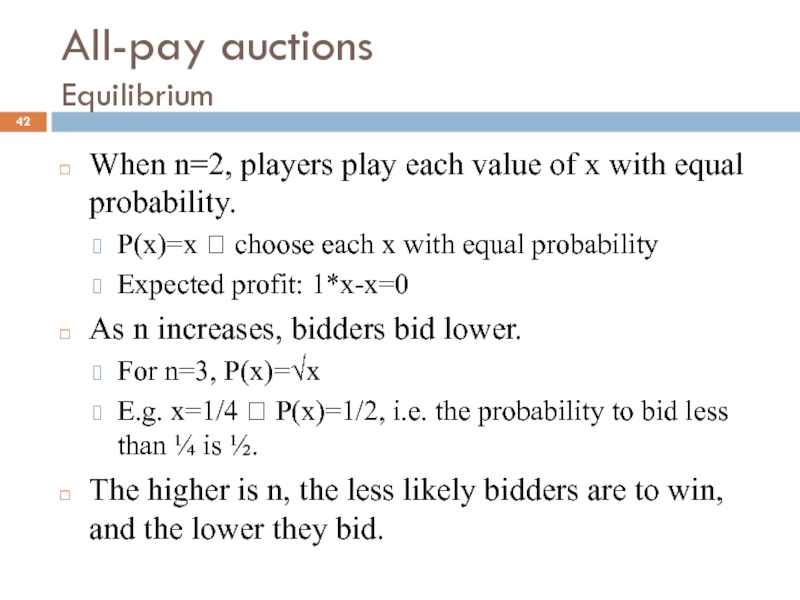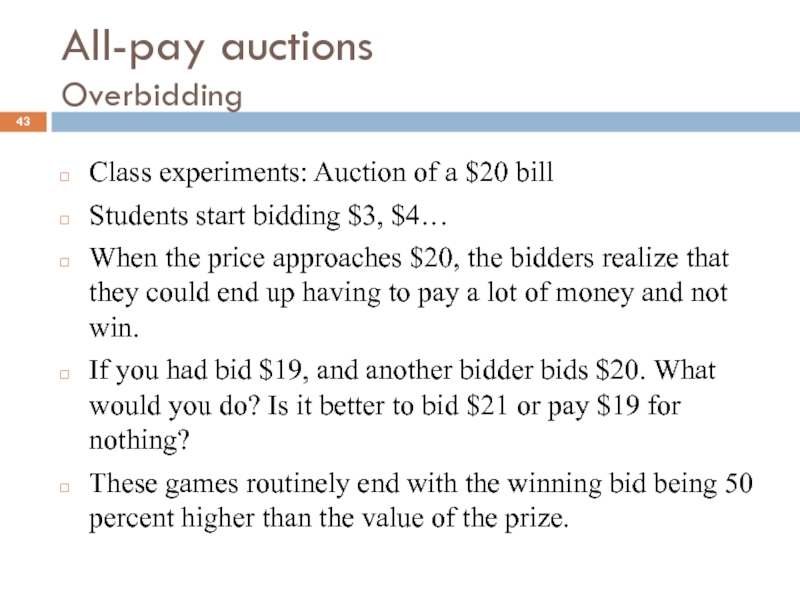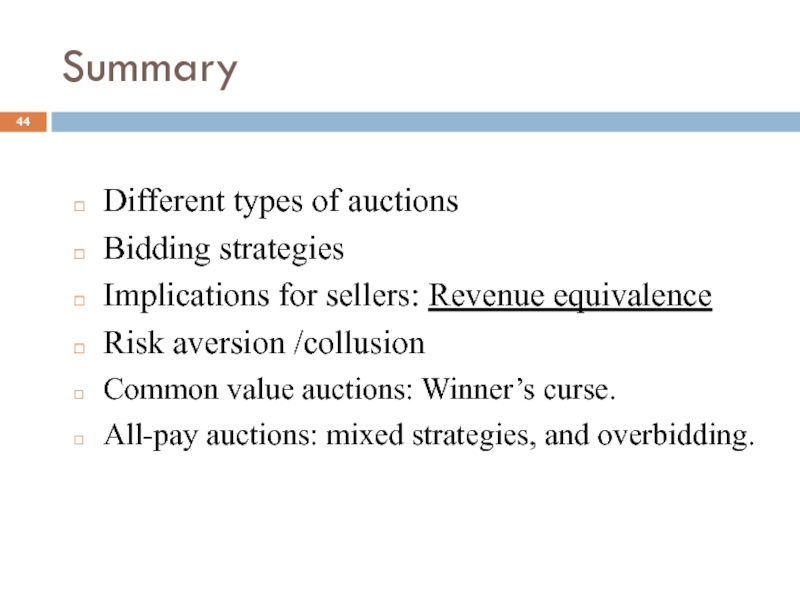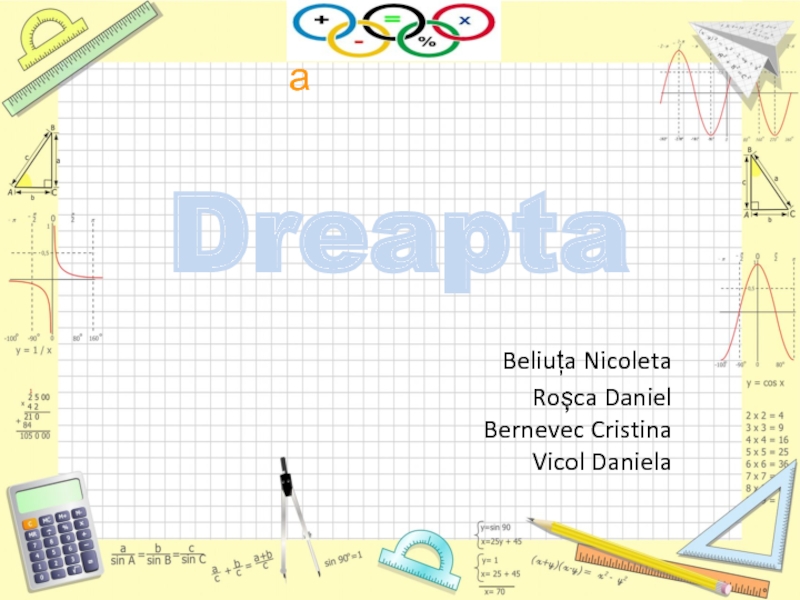- Главная
- Разное
- Дизайн
- Бизнес и предпринимательство
- Аналитика
- Образование
- Развлечения
- Красота и здоровье
- Финансы
- Государство
- Путешествия
- Спорт
- Недвижимость
- Армия
- Графика
- Культурология
- Еда и кулинария
- Лингвистика
- Английский язык
- Астрономия
- Алгебра
- Биология
- География
- Детские презентации
- Информатика
- История
- Литература
- Маркетинг
- Математика
- Медицина
- Менеджмент
- Музыка
- МХК
- Немецкий язык
- ОБЖ
- Обществознание
- Окружающий мир
- Педагогика
- Русский язык
- Технология
- Физика
- Философия
- Химия
- Шаблоны, картинки для презентаций
- Экология
- Экономика
- Юриспруденция
Auctions. (Lecture 10) презентация
Содержание
- 1. Auctions. (Lecture 10)
- 2. What is an auction? Economic
- 4. Terminology and auction types Terminology: Bids
- 5. Sources of uncertainty Private Value
- 6. Four standard types of auction (private value
- 7. English Auction (Ascending Bid) Bidders
- 8. Dutch auction “Price Clock” ticks
- 9. Dutch auction Strategy: Buzz in after price
- 10. Dutch auction for British CO2 emissions Greenhouse
- 11. First Price Auctions All buyers
- 12. First Price Auctions Profit is Vmax -
- 13. Second Price Auctions All bidders
- 14. Second Price Auctions It is
- 15. Second Price Auctions Possible bids: B>V or B=V or B
- 16. Second Price Auctions Bidding higher than my
- 17. Second Price Auctions Bidding lower than my
- 18. Second Price Auction In a
- 19. Which auction is better for the seller?
- 20. Revenue Equivalence All 4 standard
- 21. Revenue Equivalence On average, Vmax-shading = 2nd
- 22. Are all auctions truly equivalent?
- 23. Are all auctions truly equivalent?
- 24. Collusion in auctions In second-price auctions, bidders
- 25. Collusion in auctions Collusion is also possible
- 26. Number of Bidders Having more
- 27. Number of Bidders Three bidders
- 28. Number of Bidders Assume more
- 29. The European 3G telecom auctions The 2000-2001
- 30. The European 3G telecom auctions Netherlands 4
- 31. Common Value Auctions Common Value Auction The
- 32. Hypothetical Oil Field Auction
- 33. The winner’s curse The estimates are correct,
- 34. The winner’s curse Winner’s curse = In
- 35. Dealing with the winner’s curse Given that
- 36. Avoiding the winner’s curse Bidding with no
- 37. All-pay auctions Common value first-price auction in
- 38. All-pay auctions Example 3: Research and development,
- 39. All-pay auctions Optimal strategy If everyone else
- 40. All-pay auctions Equilibrium Consider an all-pay auction
- 41. All-pay auctions Equilibrium The bidder win if
- 42. All-pay auctions Equilibrium When n=2, players play
- 43. All-pay auctions Overbidding Class experiments: Auction of
- 44. Summary Different types of auctions Bidding
Слайд 2What is an auction?
Economic markets:
Many buyers & many sellers ? traditional markets
One
Many buyers & one seller ? auctions
A public sale in which property or merchandise are sold to the highest bidder.
Wine
Art
Flowers
Fish
Electric power
IPOs
Emissions permits
Oil drilling lease
Mineral rights
Treasury bills
Слайд 4Terminology and auction types
Terminology:
Bids B,
Bidder’s valuation V,
Next-highest rival bid
Small in/decrement in current highest bid: e
Classifying auctions:
Open or sealed
Multiple or single bids
Ascending or descending
First-price or second-price
Private or common-value
Слайд 5Sources of uncertainty
Private Value Auction
Bidders differ in their values for the
e.g., memorabilia, consumption items
Each bidder knows only his value for the object
Common Value Auction
The item has a single though unknown value
Bidders differ in their estimates of the true value of the object
e.g. drilling for oil
Слайд 6Four standard types of auction (private value auctions)
Open Auctions (sequential)
English Auctions
Dutch
Sealed Auctions (simultaneous)
First Price Sealed Bid
Second Price Sealed Bid
Слайд 7English Auction (Ascending Bid)
Bidders call out prices
Highest bidder wins the
Auction ends when the 2nd highest bid R is made, and the bidder with Vmax will bid extra e and wins
Winner’s profit is Vmax-(R+e)>0
Strategy: keep bidding up to your valuation V.
Vmax
B
R
e
Слайд 8Dutch auction
“Price Clock” ticks down the price.
First bidder to “buzz in”
Pays price indicated on the clock.
Слайд 9Dutch auction
Strategy: Buzz in after price falls sufficiently below V, and
“Shading”: waiting longer may increase the profit, but also increases the chance of losing the auction.
Vmax
B
R
profit
Слайд 10Dutch auction for British CO2 emissions
Greenhouse Gas Emissions Trading Scheme Auction,
UK government aimed to spend £215 million to get firms reduce CO2 emissions.
Clock auction used to determine what price to pay per unit, which firms to reward.
The clearing price was £53.37 per metric ton.
Слайд 11First Price Auctions
All buyers submit bids simultaneously.
The bidder who submits the
Слайд 12First Price Auctions
Profit is Vmax - B
Shading: B must be below
Amount of shading is trade-off between risk of losing and greater profit (similar to Dutch auction).
Shading depends on risk attitude and beliefs about other bidders’ Vs.
Vmax
B
R
Profit
Слайд 13Second Price Auctions
All bidders submit bids simultaneously.
The bidder who submits the
Слайд 15Second Price Auctions
Possible bids: B>V or B=V or B
Bidding V is a dominant strategy
Second price auctions makes bidders reveal their true valuations
Why bid V?
The amount a bidder pays does not depend on his bid, so no reason to bid less than V.
Слайд 16Second Price Auctions
Bidding higher than my valuation
B wins, pays R, profit
B wins, pays R, negative profit
B loses, profit is 0, same result if B=V
high
V
R
low
B
high
V
R
low
B
high
V
R
low
B
To bid higher than V yields either an equal or lower payoff
than to bid V ? Prefer B=V to B>V
Слайд 17Second Price Auctions
Bidding lower than my valuation
B wins, pays R, profit
B loses, while bidding B=V would have won a profit
B loses, same result if B=V
high
V
R
low
B
high
V
R
low
B
high
R
B
low
v
To bid lower than V yields either an equal or lower payoff
than to bid V ? Prefer B=V to B
Слайд 18Second Price Auction
In a second price auction, always bid your true
Winning bidder’s surplus: Difference between the winner’s valuation and the second highest valuation.
Слайд 19Which auction is better for the seller?
In a second price auction
Bidders
Seller receives the second highest bid
In a first price auction
Bidders bid below their true value
Seller receives the highest bid
Слайд 20Revenue Equivalence
All 4 standard auction formats yield the same expected revenue
Any
The prize always goes to the person with the highest valuation
A bidder with the lowest possible valuation expects zero surplus
…yield the same expected revenue
The seller is indifferent between the 4 standard auctions.
Слайд 21Revenue Equivalence
On average, Vmax-shading = 2nd highest V.
The optimal shading strategy
Слайд 22Are all auctions truly equivalent?
For sellers, all 4 standard auctions are
Risk Aversion
Does not affect the outcomes of 2nd price auctions and English auctions.
However, in 1st price auctions and Dutch auctions, risk-averse bidders are more aggressive than risk-neutral bidders. Bidders ‘shade’ less, so bid higher than if risk-neutral!
Risk aversion ? 1st price or Dutch are better for the seller, because bidders shade less.
Слайд 23Are all auctions truly equivalent?
Inexperienced bidders
In second-price auctions, it is optimal
Inexperienced bidders tend to overbid in 2nd price auctions (B>V), in order to increase their odds of winning.
With inexperienced bidders ? second-price auctions increase the revenue of the seller.
Слайд 24Collusion in auctions
In second-price auctions, bidders may agree not to bid
e.g. there are 10 bidders, John’s valuation is $20, others have valuation of $18.
Bidders agree that the designated winner John bids any amount more than $18, others bid $0 - no incentive for anyone to do differently. The bidder wins the item for $0.
In first-price auctions, instead, if John bids $18, he pays $18 to the seller.
Слайд 25Collusion in auctions
Collusion is also possible in English auctions. Bidders may
Bidders who realize that they do not have the highest valuations may collude with the Vmax bidder by accepting not to raise their bid.
Слайд 26Number of Bidders
Having more bidders leads to higher prices.
Example: Second price
Two bidders
Each has a V of either 20 or 40.
There are four possible combinations:
Pr{20,20}=Pr{20,40}=Pr{40,20}=Pr{40,40}= ¼
Expected price = ¾ (20)+ ¼ (40) = 25
Слайд 27Number of Bidders
Three bidders
Each has a V of either 20 or
There are eight possible combinations:
Pr{20,20,20}=Pr{20,20,40}=Pr{20,40,20}
= Pr{20,40,40}=Pr{40,20,20}=Pr{40,20,40}
= Pr{40,40,20}=Pr{40,40,40}= 1/8
Expected price = ½ (20)+ ½ (40) = 30
Слайд 29The European 3G telecom auctions
The 2000-2001 European auctions of 3G mobile
UK
5 licences; 4 incumbents. At least one new entrant would win a license.
Used English auction. New entrants knew they had a chance so they bid aggressively, forcing incumbents to do the same.
Revenue: 39bn euros.
Слайд 30The European 3G telecom auctions
Netherlands
4 licences; 4 incumbents.
Potential entrants could
Used English auction. Raised only 3bn euros.
Another problem is the sequencing. Because the auction took place after the UK one, bidders had learned how to collude.
The same problem occurred in countries that organized auctions later, e.g. Italy and Switzerland. Bidders had learned how to collude.
Слайд 31Common Value Auctions
Common Value Auction
The item has a single though unknown
Example: Oil drilling lease
Value of oil is roughly the same for every participant.
No bidder knows for sure how much oil there is.
Each bidder has some information.
Слайд 32Hypothetical Oil Field Auction
Each bidder knows the amount
Total value of oil field: Sum of the values of the four quarters
Type of auction: First price sealed bid
Слайд 34The winner’s curse
Winner’s curse = In common value auctions, winners
are
high
V
low
B
B
B
B
B
B
B
B
B
B
B
B
B
B
B
B
B
B
B
B
B
B
B
B
Слайд 35Dealing with the winner’s curse
Given that I win an auction …All
Winning the auction is “bad news”. One must incorporate this into one’s bid, i.e. lower your bid. Assume that your estimate is the most optimistic.
Слайд 36Avoiding the winner’s curse
Bidding with no regrets:
Since winning means you have
If your estimate is the most optimistic –what is the item worth?
Use that as the basis of your bid.
Слайд 37All-pay auctions
Common value first-price auction in which bidders pays the amount
Example 1: Olympic games
Competing cities spend vast amount of resources to win the vote.
Example 2: Political contests (elections)
Candidates spend time and money, whether they win or lose.
In the 2012 US presidential election, total campaign spending was close to $2bn.
Слайд 38All-pay auctions
Example 3: Research and development, patent race.
Competing pharmaceutical firms search
Investment in R&D is risky, since even losers lose their “bid”.
Bid is useless unless you win…hence bid aggressively or don’t bid at all.
Typically, the sum of the bids is much higher than the value of the prize, which is good for the seller.
Слайд 39All-pay auctions
Optimal strategy
If everyone else bids aggressively, your best response is
If everyone else bids 0, your best response is to bid a small positive amount
? Equilibrium bidding strategy must be a mixed strategy.
Слайд 40All-pay auctions
Equilibrium
Consider an all-pay auction with prize worth 1, n bidders.
Bid
Let P(x) be the probability one’s bid is not higher than x.
Indifference principle: With mixed strategies bidders must be indifferent between the choice of x
Слайд 41All-pay auctions
Equilibrium
The bidder win if all remaining bids are less than
1*[P(x)]n-1-x
Indifference condition between bidding 0 and x (the expected profit is 0):
[P(x)]n-1-x =0, i.e. P(x)=x 1/(n-1)
Слайд 42All-pay auctions
Equilibrium
When n=2, players play each value of x with equal
P(x)=x ? choose each x with equal probability
Expected profit: 1*x-x=0
As n increases, bidders bid lower.
For n=3, P(x)=√x
E.g. x=1/4 ? P(x)=1/2, i.e. the probability to bid less than ¼ is ½.
The higher is n, the less likely bidders are to win, and the lower they bid.
Слайд 43All-pay auctions
Overbidding
Class experiments: Auction of a $20 bill
Students start bidding $3,
When the price approaches $20, the bidders realize that they could end up having to pay a lot of money and not win.
If you had bid $19, and another bidder bids $20. What would you do? Is it better to bid $21 or pay $19 for nothing?
These games routinely end with the winning bid being 50 percent higher than the value of the prize.
Слайд 44Summary
Different types of auctions
Bidding strategies
Implications for sellers: Revenue equivalence
Risk aversion
Common value auctions: Winner’s curse.
All-pay auctions: mixed strategies, and overbidding.

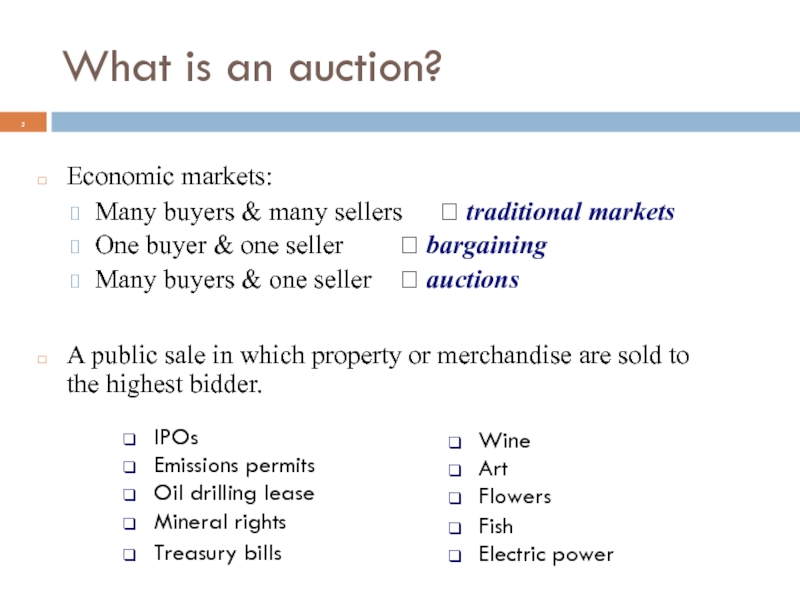
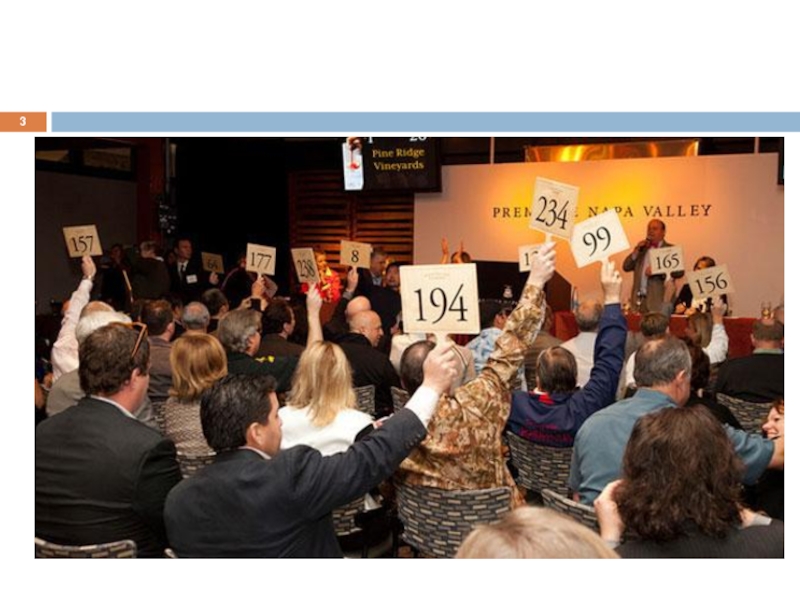
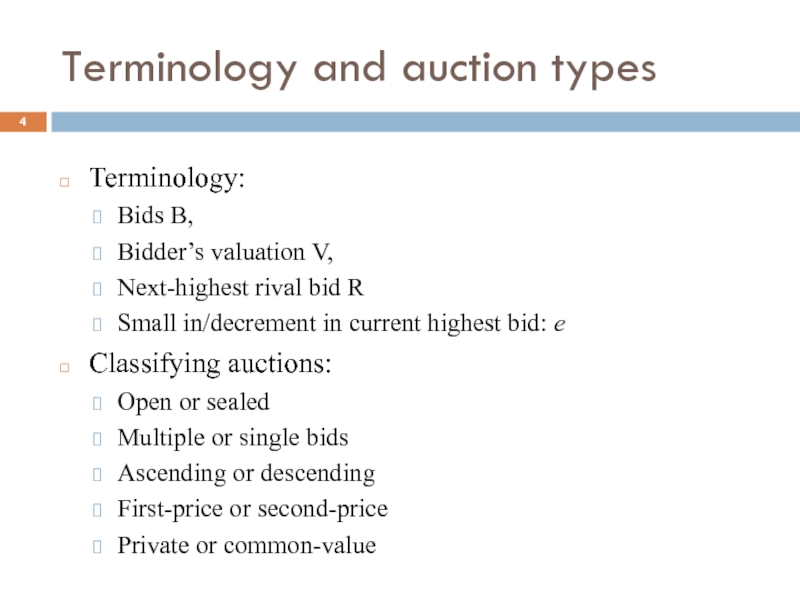

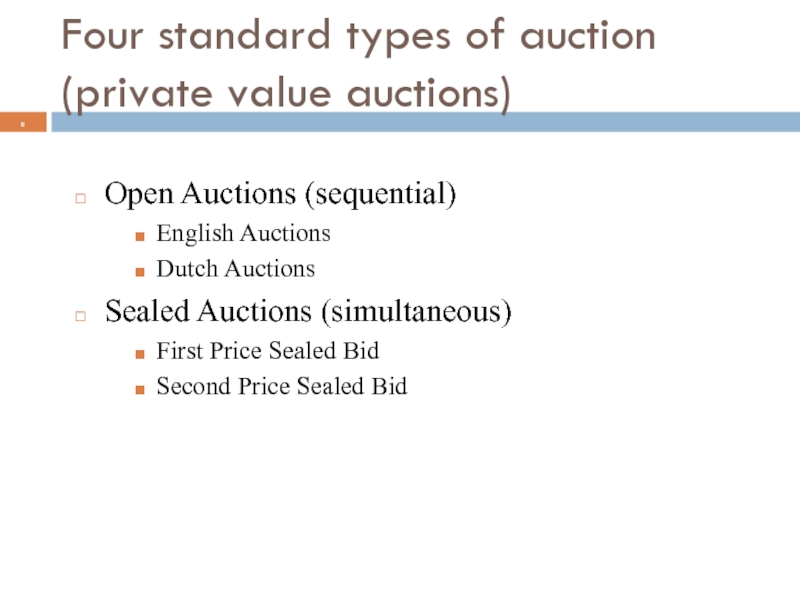

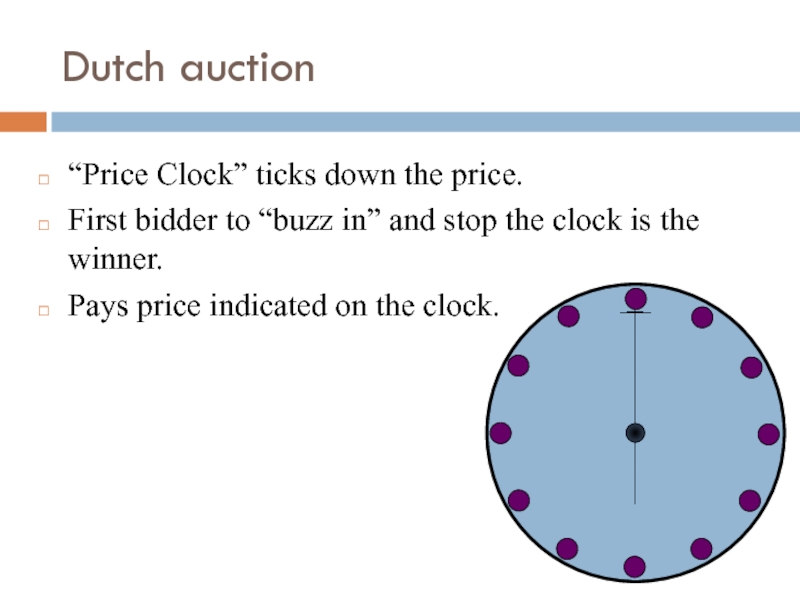
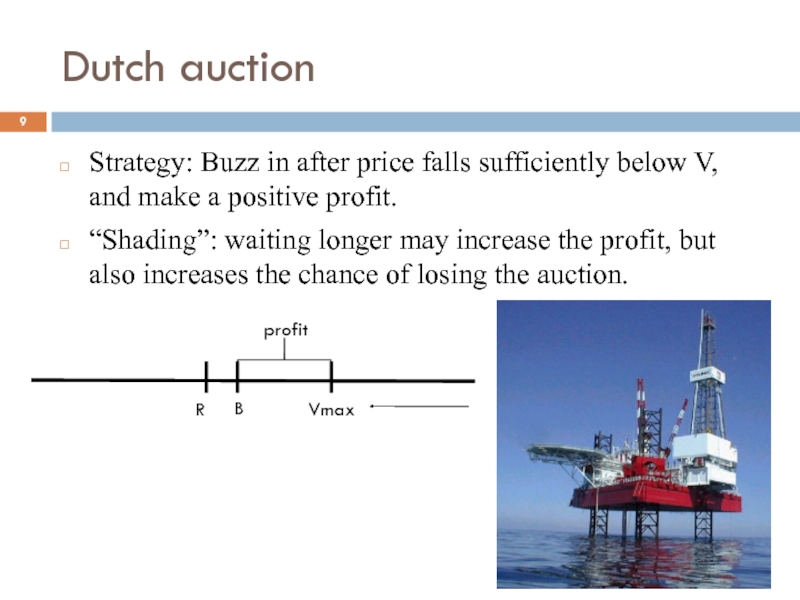

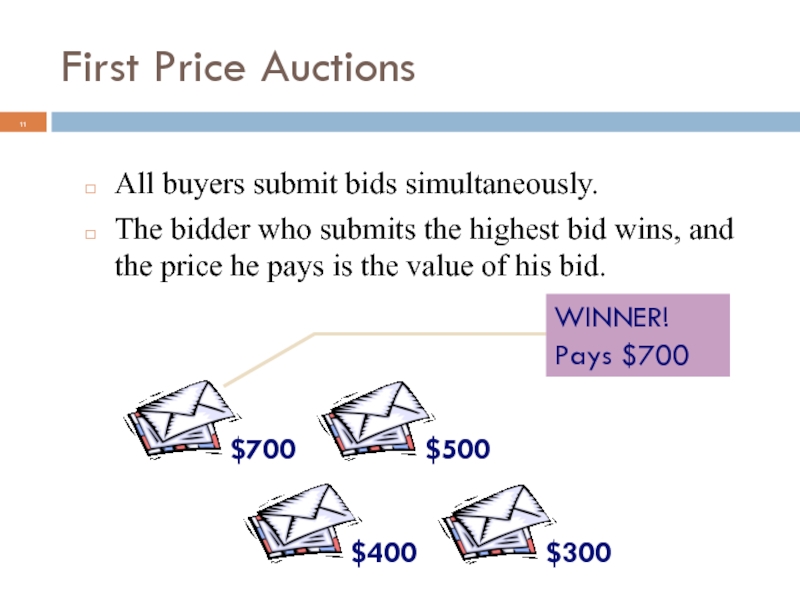
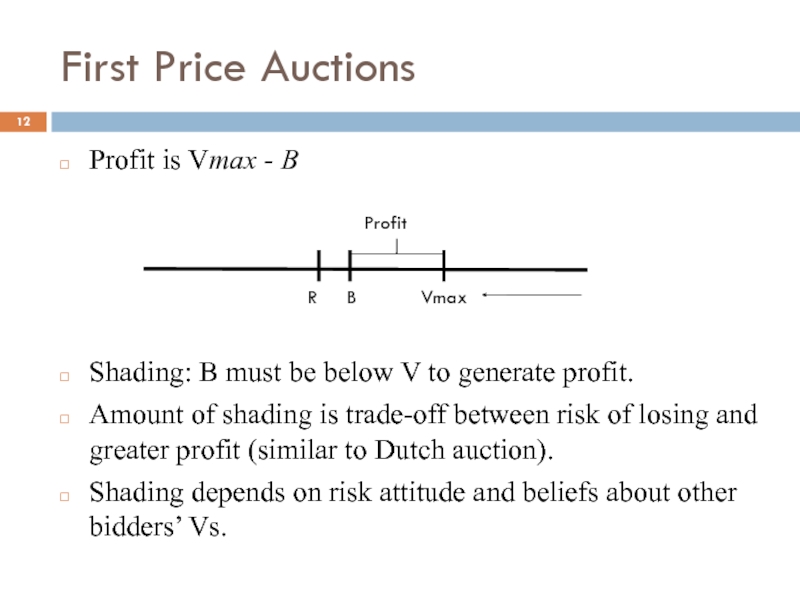
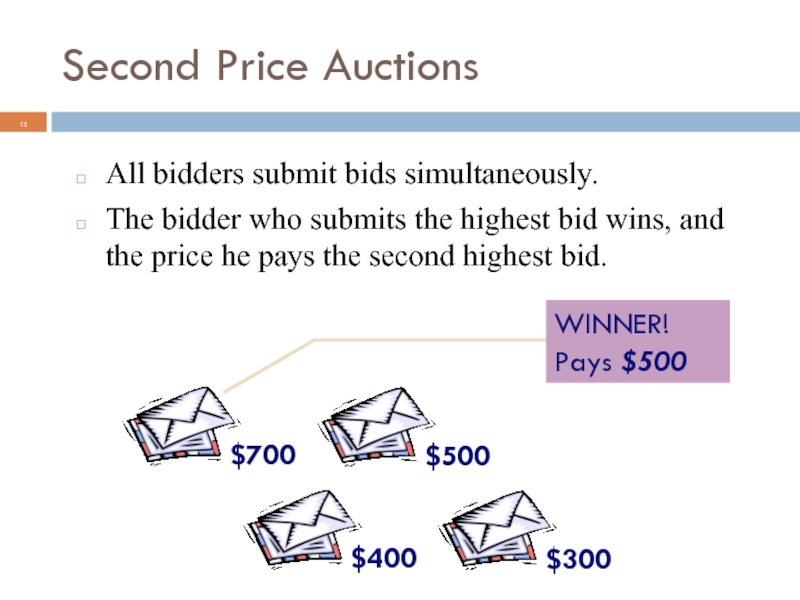
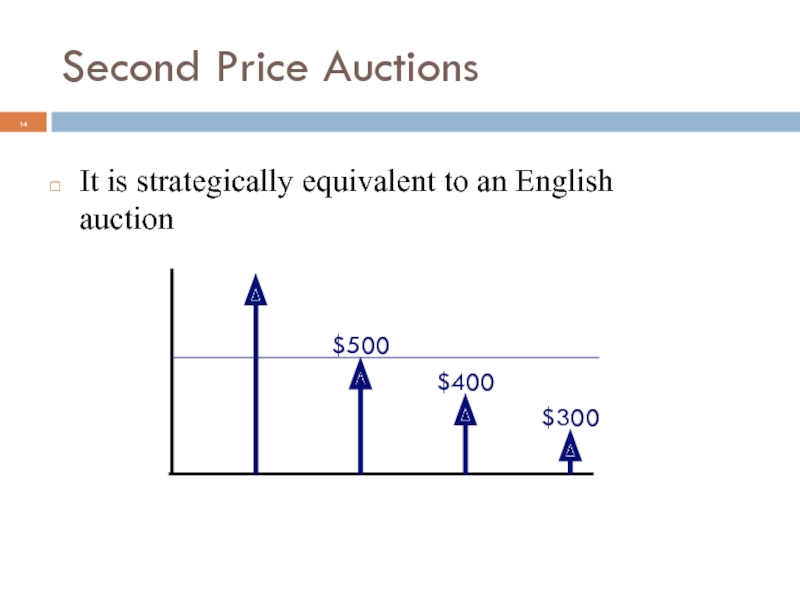

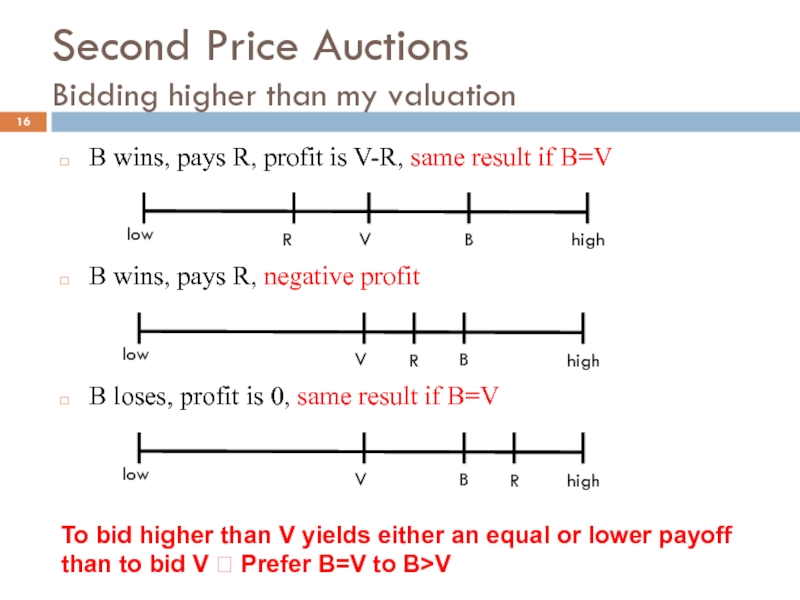
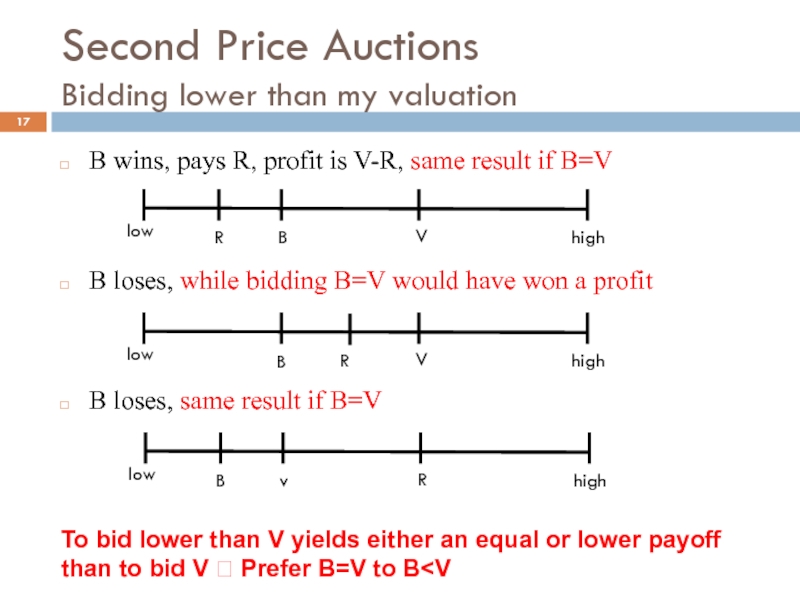
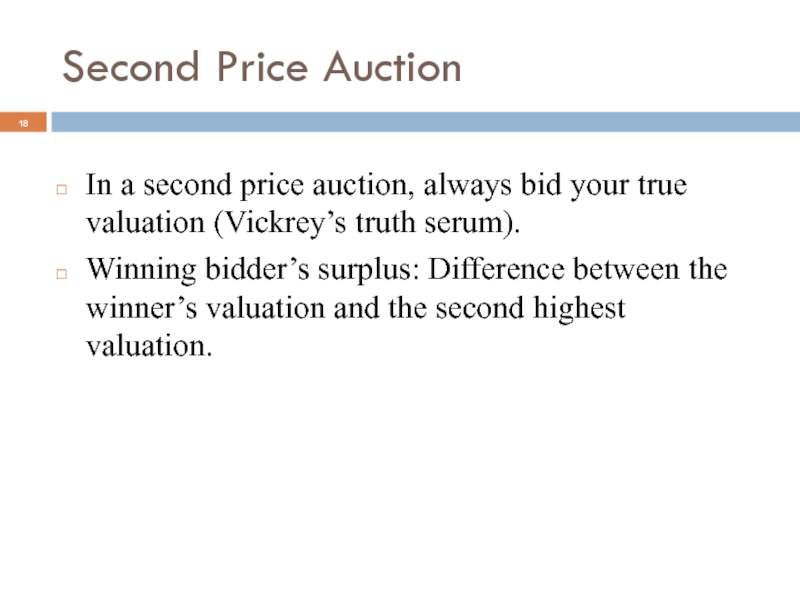
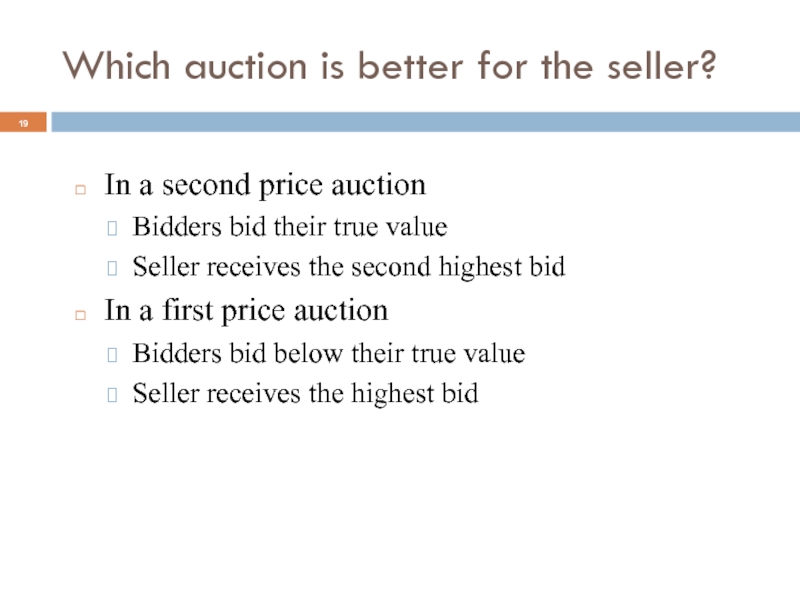

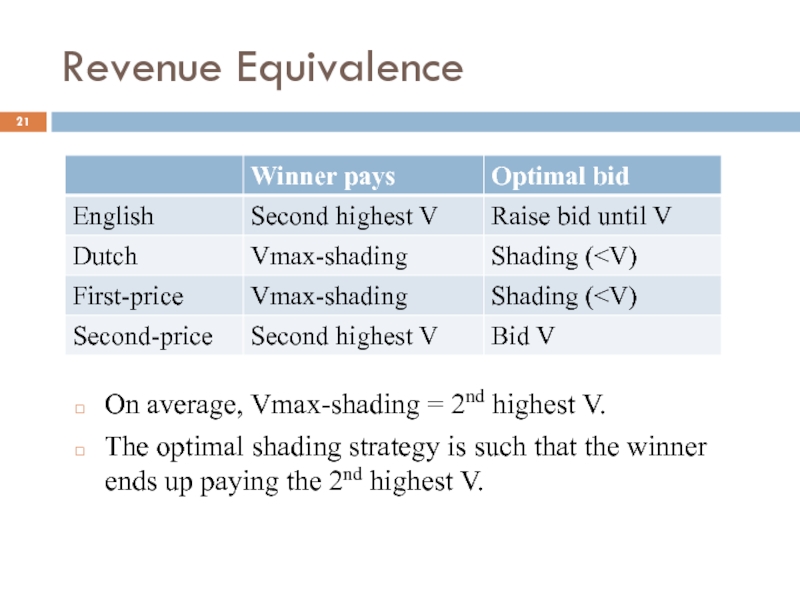
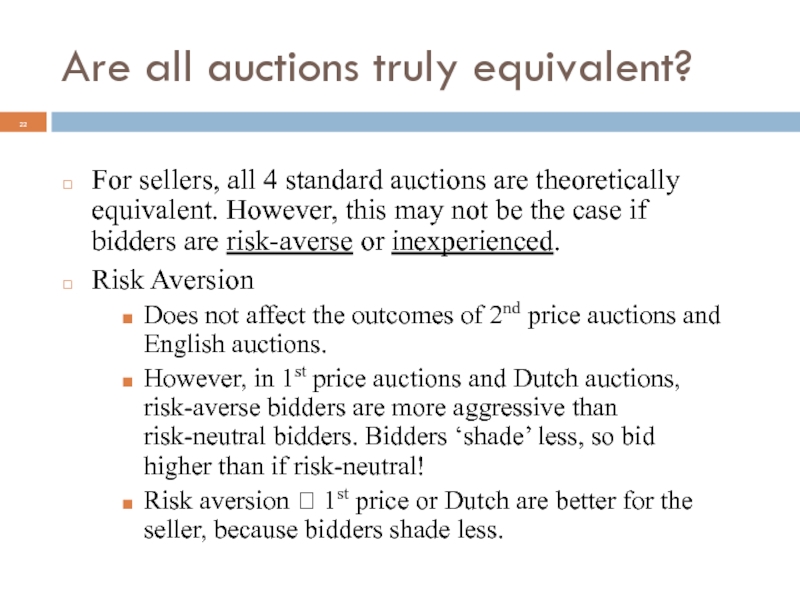
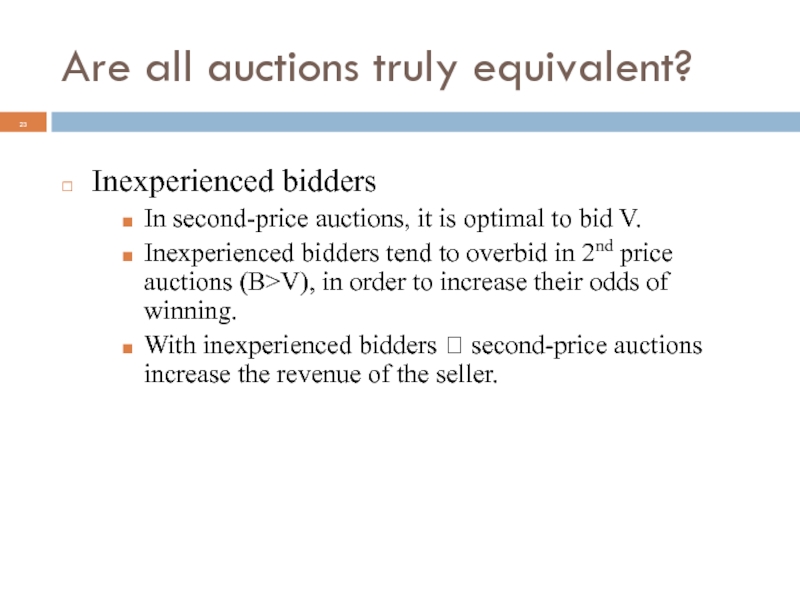
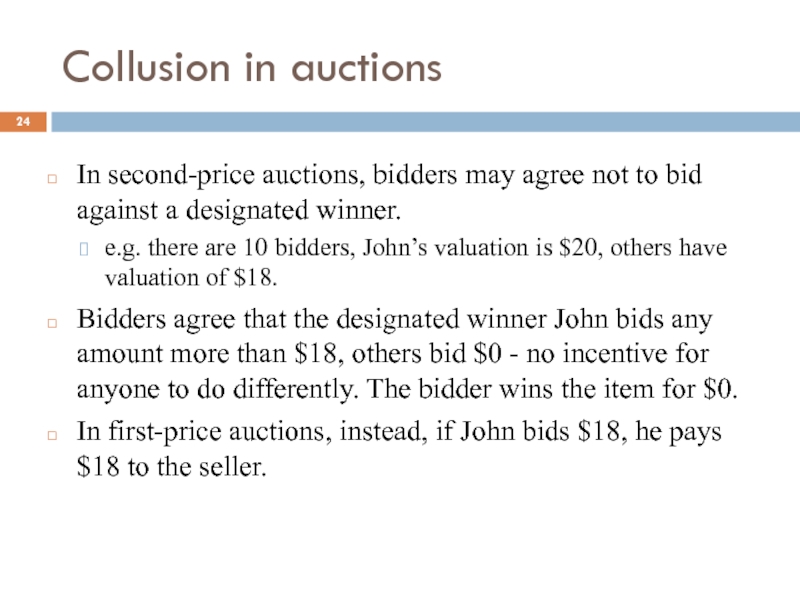
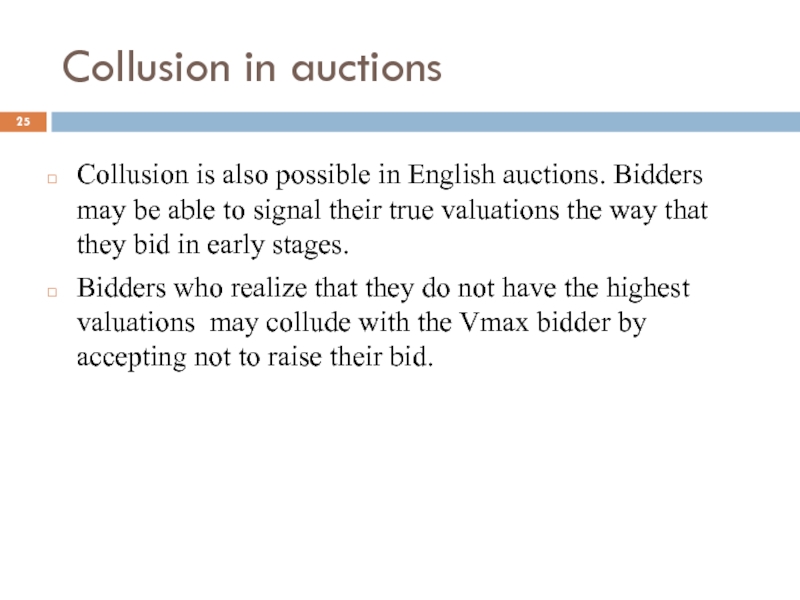
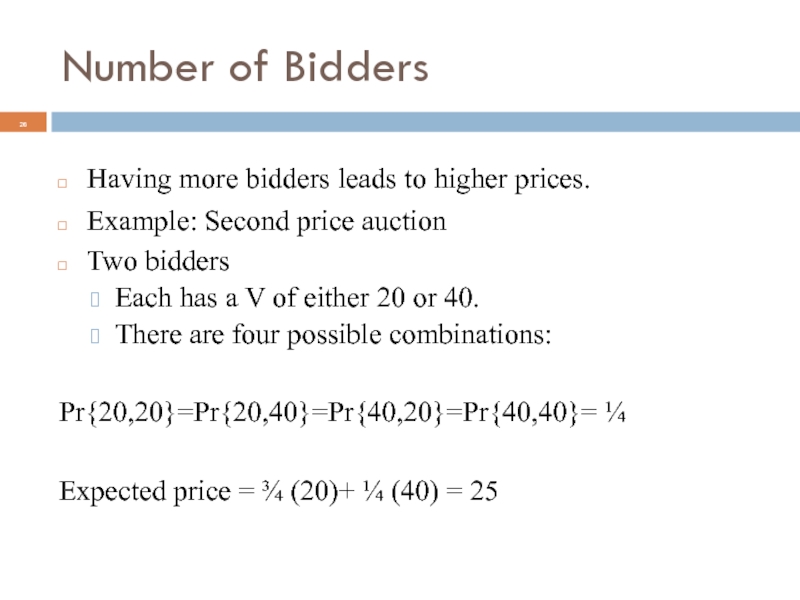
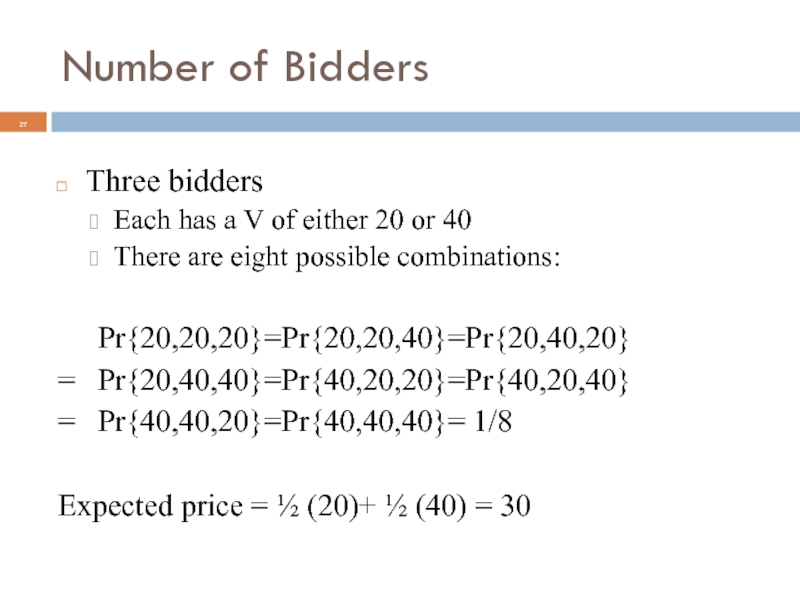
![Number of BiddersAssume more generally that valuations are drawn uniformly from [20,40]:](/img/tmb/4/351251/008d03fa6d99d16f433f86de87d41499-800x.jpg)
